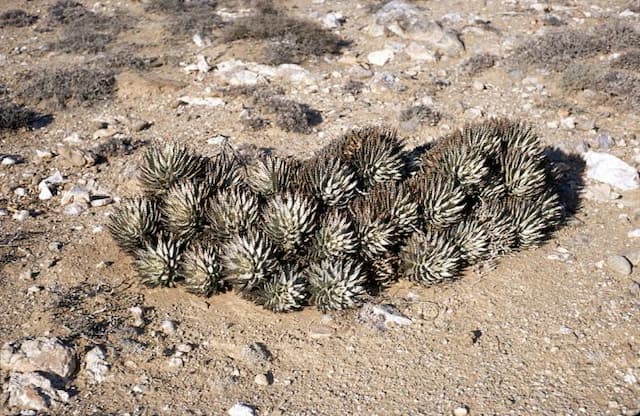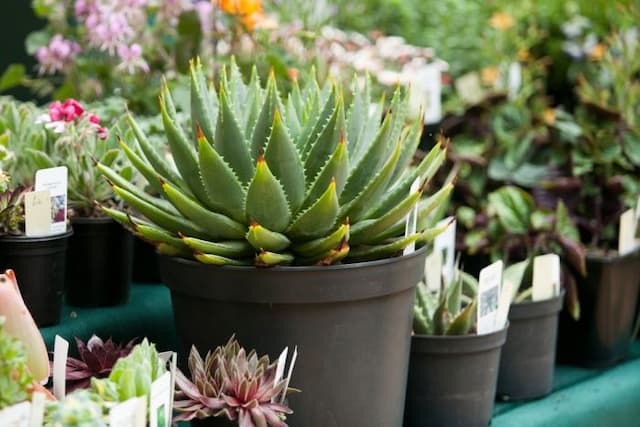Red Hot Poker Kniphofia 'Penny Rockets'

ABOUT
The Kniphofia 'Penny Rockets', commonly known as Red Hot Poker, is a distinctive perennial that adds a burst of color to any garden. Bearing a striking resemblance to a torch or poker, this plant is well-known for its vibrant flower spikes. The blooms are tubular and densely packed, arranged in a conical inflorescence that transitions in color from bottom to top, featuring shades of a warm color palette – commonly red, orange, and yellow. The bottom flowers bloom first, creating a gradient of color as the eye moves upward along the flower spike. Flanked by a basal clump of narrow, grass-like foliage, the leaves of the Red Hot Poker are deep green and grow in an arching fashion, creating a fountain-like effect that serves as an attractive backdrop for the eye-catching floral display. The foliage remains evergreen in milder climates, providing year-round interest even when the plant is not in flower. The overall visual impression of the Red Hot Poker is one of boldness and drama, making it a focal point in the garden whenever it is in bloom. The verticality of its flower spikes contrasts sharply with the sprawling nature of the leaves, creating a dynamic and architectural aesthetic. Its fiery-colored blooms are not only appealing to garden admirers but are also a magnet for hummingbirds and other pollinators, bringing an additional layer of life and activity to its surroundings.
About this plant
 Names
NamesFamily
Asphodelaceae
Synonyms
Red Hot Poker, Torch Lily, Tritoma
Common names
Kniphofia 'Penny Rockets'
 Toxicity
ToxicityTo humans
Red hot poker, including the variety 'Penny Rockets', is generally not considered toxic to humans. Ingesting parts of the plant is unlikely to cause serious poisoning. However, some individuals may experience mild stomach upset or irritation if they consume the plant. It is always advisable to avoid eating plants that are not commonly recognized as edible due to the potential for allergic reactions or gastrointestinal discomfort.
To pets
Red hot poker, known in the 'Penny Rockets' variety, is also not considered highly toxic to pets. While it is always best to prevent pets from eating ornamental plants, ingestion of red hot poker is unlikely to result in serious toxicity. Symptoms of plant ingestion in pets could include mild gastrointestinal upset, such as vomiting or diarrhea. If a pet ingests a significant amount, or shows signs of distress, contacting a veterinarian is recommended.
 Characteristics
CharacteristicsLife cycle
Perennials
Foliage type
Evergreen
Color of leaves
Green
Flower color
Mixed
Height
3 feet 6 inches (1.07 meters)
Spread
2 feet (0.61 meters)
Plant type
Herbaceous
Hardiness zones
6
Native area
South Africa
Benefits
 General Benefits
General Benefits- Attracts Pollinators: Kniphofia 'Penny Rockets', commonly known as Red Hot Poker, is known for attracting bees, butterflies, and birds, which can help pollinate your garden.
- Long Blooming Season: This perennial typically enjoys a long blooming season, bringing color to your garden from early summer to early autumn.
- Drought Tolerant: Once established, Red Hot Poker can tolerate periods of drought, making it a great choice for water-wise gardens.
- Deer Resistant: The plant tends to be resistant to deer, which is beneficial if you're in an area where deer predation is a problem.
- Low Maintenance: Red Hot Poker does not require a lot of care once planted, making it an ideal choice for gardeners looking for low-maintenance options.
- Bold Focal Point: With its striking flower spikes and tall stature, it provides a vibrant focal point in any landscape or garden setting.
- Versatile Landscape Use: This plant is suitable for a range of garden areas, including borders, cutting gardens, and as part of drought-tolerant landscaping schemes.
 Medical Properties
Medical PropertiesThis plant is not used for medical purposes.
 Air-purifying Qualities
Air-purifying QualitiesThis plant is not specifically known for air purifying qualities.
 Other Uses
Other Uses- Ecological support: Red hot poker can provide nectar for hummingbirds and butterflies, serving as a food source in the garden ecosystem.
- Architectural interest: With its towering flower spikes, the plant can add vertical interest to landscape design in contemporary gardens.
- Thermal mass in permaculture: The dense clumps formed by Red hot poker can store heat and regulate temperature fluctuations in permaculture gardens.
- Natural pest control: When planted strategically, Red hot poker can help deter certain pests due to its shape and structure.
- Artistic inspiration: The vivid colors and unique shape of the Red hot poker blooms can inspire artists and photographers for various artistic creations.
- Erosion control: The fibrous root system of the Red hot poker can help in stabilizing slopes and controlling erosion.
- Seasonal marker: It can be used by gardeners to indicate the start of summer as Red hot poker typically blooms in early to mid-summer.
- Dried flower arrangements: Red hot poker flowers can be dried and used in long-lasting floral displays.
- Teaching tool: Red hot poker plants can be used in educational settings to teach about pollination and plant morphology.
- Winter garden interest: In areas where the foliage remains evergreen, it can provide color and texture to winter landscapes.
Interesting Facts
 Feng Shui
Feng ShuiThe Red Hot Poker is not used in Feng Shui practice.
 Zodiac Sign Compitability
Zodiac Sign CompitabilityThe Red Hot Poker is not used in astrology practice.
 Plant Symbolism
Plant Symbolism- Stimulation of Energy: The vibrant red and orange colors of the Red Hot Poker plant are often associated with an infusion of energy or a call to action, reflecting the plant's fiery hues.
- Attraction: This plant can symbolize attraction or magnetism, possibly due to its striking appearance that draws the eye and attention of onlookers.
- Standing Out: The unique shape and bold colors of the Red Hot Poker plant make it a symbol for individuality and standing out from the crowd.
- Courage and Boldness: The term 'poker' can be associated with a sense of boldness or courage, which can be symbolically represented by the Red Hot Poker plant.
- Wealth and Prosperity: In some cultural contexts, the lush and vigorous growth of this plant might be seen as an emblem of wealth and prosperity.
 Water
WaterRed Hot Poker plants prefer even moisture, so water thoroughly whenever the top inch of soil feels dry to the touch. In general, this might mean watering once a week, providing about 1 inch of water each time, which is roughly equivalent to 0.623 gallons per square yard. During hot, dry spells, you may need to water twice a week. It’s important to avoid overwatering, as this can lead to root rot. Ensure that the plant is in well-draining soil so excess water can escape.
 Light
LightRed Hot Pokers thrive in full sun, meaning they require at least 6 hours of direct sunlight daily to flourish. The ideal spot for these plants is in an area with unobstructed sunlight, away from the shade of trees or buildings. They can tolerate some partial shade, but too little light can reduce blooming and weaken the plant.
 Temperature
TemperatureRed Hot Pokers are hardy in a range of temperatures and can endure temperatures as low as 0°F, making them suitable for USDA zones 5 through 9. They can survive high temperatures well into the 90s°F. The ideal temperature range for these plants to thrive is between 50°F and 75°F.
 Pruning
PruningPruning Red Hot Pokers is essential for maintaining plant health and encouraging more blooms. Deadhead spent flower stalks throughout the blooming season to promote new flowers. After flowering, cut back foliage to about 3 inches from the ground in late fall to tidy up the plant and help prevent disease. The best time for more substantial pruning is in early spring, just before new growth begins.
 Cleaning
CleaningAs needed
 Soil
SoilThe best soil mix for Red Hot Poker (Kniphofia 'Penny Rockets') is well-draining and rich in organic matter. A mixture that consists of two parts loam, one part sand or perlite, and one part compost or well-rotted manure will provide a suitable structure and nutrient level for the plant. The soil pH should be slightly acidic to neutral, ranging from 6.0 to 7.0, to ensure optimal growth.
 Repotting
RepottingRed Hot Poker (Kniphofia 'Penny Rockets') generally does not need to be repotted often, as it is a perennial that can be divided every 3-5 years. Repotting is usually done in the spring or early autumn to give the plant time to establish its roots before the growing or dormant seasons.
 Humidity & Misting
Humidity & MistingRed Hot Poker (Kniphofia 'Penny Rockets') is tolerant of a wide range of humidity levels and does not have specific humidity requirements. It is well-adapted to outdoor conditions, so as long as it is not in excessively dry indoor air, it should thrive without the need for additional humidity adjustments.
 Suitable locations
Suitable locationsIndoor
Place in bright light, avoid excess water, fertilize lightly.
Outdoor
Plant in full sun, well-draining soil, protect from extreme cold.
Hardiness zone
6-9 USDA
 Life cycle
Life cycleKniphofia 'Penny Rockets', also known as Red Hot Poker or Torch Lily, begins as a seed which germinates in warm, moist soil, typically in spring or early summer. After germination, the seedling emerges and develops into a juvenile plant with a rosette of narrow, strap-like leaves. As the plant matures, it forms a deep root system, and in its second or third year, it produces tall, sturdy flower spikes topped with tubular flowers that range from red to yellow. The blooming period occurs in the summer and may continue into fall, attracting pollinators such as bees and hummingbirds. Following pollination, the flowers develop into seed capsules containing numerous seeds that can disperse to create new plants. The plant then enters a period of dormancy during colder months, though in milder climates it may retain its foliage year-round, and resumes growth with the return of warmer weather.
 Propogation
PropogationPropogation time
Spring to Summer
The most popular method of propagation for Kniphofia 'Penny Rockets', commonly known as Red Hot Poker, is by division of mature clumps. This is typically done in spring before the plants begin their active growth. To divide, carefully dig up an established clump and use a sharp knife or spade to split the clump into smaller sections, ensuring each has a portion of the root system. The divisions should then be replanted at the same depth they were growing at before, spaced about 18 inches (approximately 45 centimeters) apart to allow room for growth. Water the new divisions thoroughly to help establish them. This method of division helps to rejuvenate older plants that may be flowering less and increases the number of plants in your garden.









